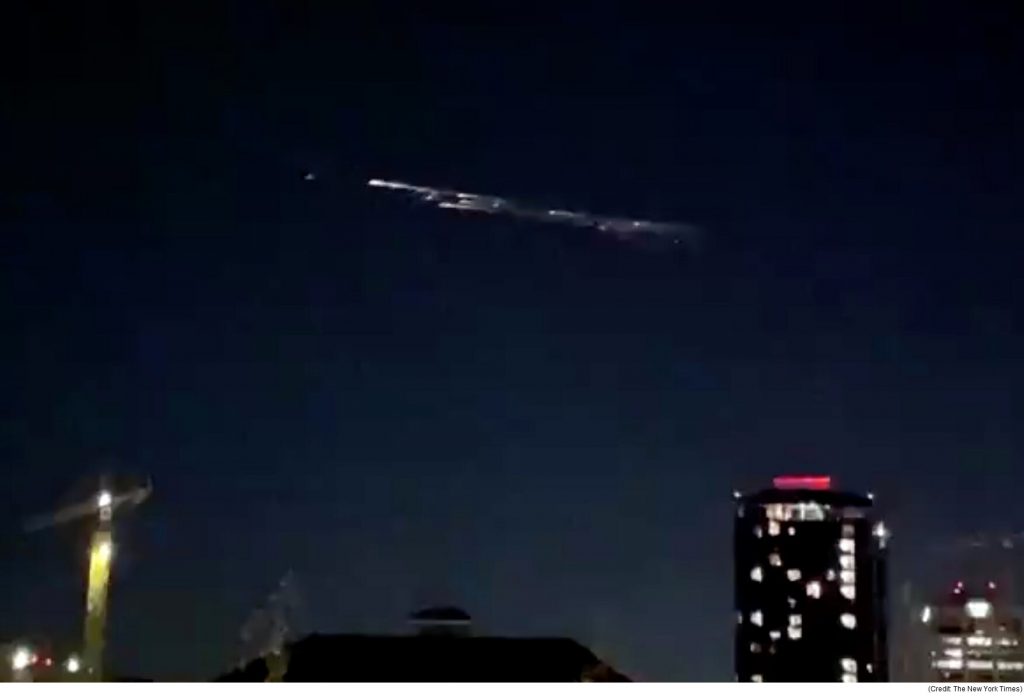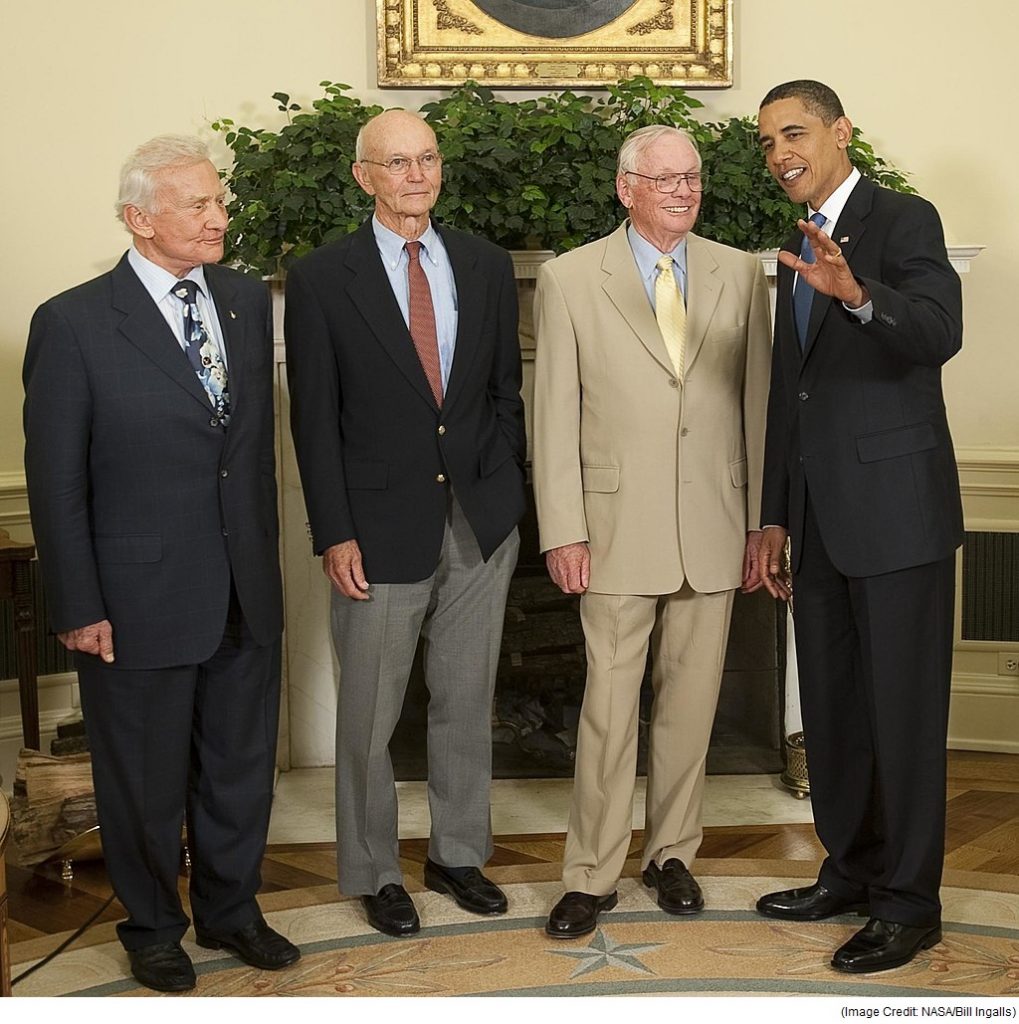SpaceX’s Space Junk Flying Over Seattle. Who’s Responsible for Cleaning the Space Debris?

Last night (Thursday, March 26, 2021) there was something interesting flying across the Pacific Northwest. It wasn’t a shooting star or some UFO. It was the second stage of Falcon 9, SpaceX’s reusable rocket. According to astronomer Jonathan McDowell, “The Falcon 9 second stage from the Mar 4 Starlink launch failed to make a deorbit burn and is now reentering after 22 days in orbit. Its reentry was observed from the Seattle area at about 0400 UTC Mar 26.”
I am sure you’re wondering where the debris from Falcon 9 stage 2 is going to land. According to The New York Times, “Mr. McDowell wrote that the “space junk” visible over Seattle was the result of a breakup that happened about 30 miles above where airplanes fly. The Falcon 9 debris falling to earth was “unlikely to be major,” he added, and would most likely fall in the Rocky Mountains near the Canadian border.”
Seattle’s local NBC affiliate King 5 posted a video taken from Bainbridge Island, just across Seattle. It gives you a clear view for miles. According to King 5, “Stephen Vilke captured footage of the SpaceX rocket debris from Bainbridge Island. Vilke said he has a pair of 4K cameras pointed east and west at Puget Sound to capture video of orcas, submarines, sunrises and sunsets, but now he will know to keep an eye out for rockets as well.”
The full video gives you an awesome view, first from one camera facing East and then a different view from the second camera facing West, so make sure you watch the full video. It’s best to watch this video in full-screen mode on your desktop or laptop computer. By the way, the date displayed on the video camera is incorrect. This event took place on Friday, March 26, 2021 at about 9:00 PM PST.
What Exactly is Falcon 9?
Falcon 9 is a two-stage reusable rocket manufactured by SpaceX in the United States. It’s the world’s first reusable rocket built to take people and cargo into the Earth’s orbit. Falcon 9 is 229.6 feet in height and 12 feet in diameter. It has two large components called stages and a center piece (called interstage) that connects the two stages. The first stage uses nine SpaceX Merlin engines and generates 1.7 million lbs. of thrust. The second stage uses one Merlin engine and carries the payload to the orbit. The first stage essentially does the initial heavy lifting, then the second stage takes the payload to the orbit. The first stage is reused, but the second stage is allowed to deorbit and reenter the Earth’s atmosphere, so it’s left to burn. Keep in mind, the first stage has nine Merlin engines, while the second stage has only one. Therefore, the loss of second stage isn’t as bad as losing stage one. Elon Musk believes it’s not worth spending the money to figure out a way to reuse second stage.
The term stage may be confusing if you’re not quite familiar with the Falcon 9. The stages are not phases of a mission, they are actually the hardware, as depicted in the following image. The other thing that may be confusing is that the part in the front of the rocket is called second stage and the part in the back is first stage.
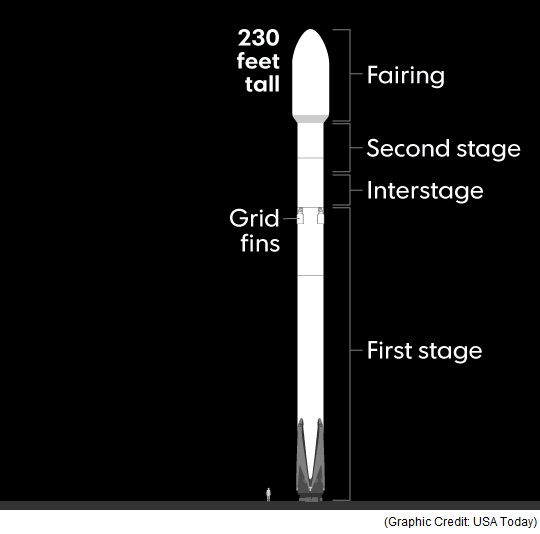
The fairing is made of carbon composite material and protects the payload, like satellite, during its journey to the orbit. Although the fairing is discarded after a few minutes into flight, SpaceX recovers it for future missions. The interstage connects the two stages together. It’s designed to allow a smooth separation of the two stages during flight. As an engineer, I appreciate the simplicity and efficiency of Falcon 9 rocket design. At the lower part of the interstage, there are four fins that are used to guide the rocket during reentry by moving the center of pressure. The interstage is never separated from the first stage. If you look at the animation below, you will notice that in step #5 the grid fins guide the rocket so it can orient itself and land vertically on the ground on its landing legs. The Falcon 9 rocket is an incredible achievement by SpaceX engineers.
Check out USA Today’s Anatomy of a SpaceX launch. It’s an excellent graphical depiction of the SpaceX launch from start to finish and shows how it deploys a satellite in space. Although the content is from 2017, it does a good job of explaining the 6 steps in the following animation.
How SpaceX launches a rocket and lands stage 1 back safely on Earth. (Credit: USA Today)
Yesterday’s spectacular event brings back the memories of the Apollo and the Space Shuttle programs. These programs were perhaps the two most famous programs because they involved crewed missions. As you’ll learn later in this article, the space wasn’t as “messy” back then. Here’s my perspective and some memories of the Apollo 11 mission and the space shuttle program.
Apollo 11’s Historic Mission
If it weren’t for President John F. Kennedy’s bold and challenging proposal in front of the joint session of the United States Congress on May 25, 1961, this world would have been much different today. President Kennedy said, “I believe that this nation should commit itself to achieving the goal, before this decade is out, of landing a man on the moon and returning him safely to the earth. No single space project in this period will be more impressive to mankind, or more important for the long-range exploration of space; and none will be so difficult or expensive to accomplish.” He was absolutely right on every single count.
Fast forward to July 20, 1969, as Astronaut Neil Armstrong stepped on the Moon, he uttered the famous words that would be remembered forever: “That’s one small step for man. One giant leap for mankind.” It was the Apollo 11’s mission to the Moon that got so many people of all ages interested in the space exploration…..exactly as President Kennedy had predicted.
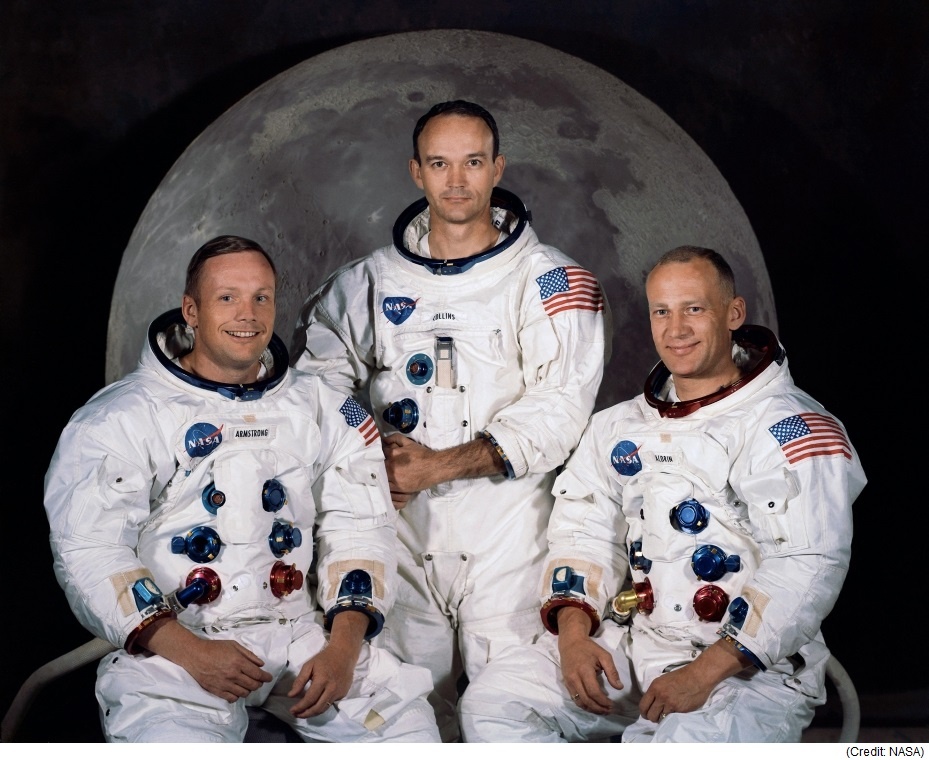
Apollo 11 crew: Neil Armstrong, Buzz Aldrin, and Michael Collins
There were too many amazing things about that mission. Frankly, it was absolutely miraculous. The Apollo Guidance Computer (AGC), one on the Apollo command module and the other on the lunar module, navigated and controlled the spacecraft. How powerful was that computer? Well, according to ZME Science, “iPhone 6’s clock is 32,600 times faster than the best Apollo era computers and could perform instructions 120,000,000 times faster. You wouldn’t be wrong in saying an iPhone could be used to guide 120,000,000 Apollo era spacecraft to the moon, all at the same time.” Keep in mind these numbers are for the old iPhone 6, not the current iPhone 12. Even a pocket calculator used by kids these days is much more powerful than the Apollo 11’s computer. That’s why it was an extremely risky mission, nothing short of a miracle. Everything had to work out perfectly. There wasn’t much margin for errors. The astronauts’ splash landing in the ocean was pretty scary because NASA had to go rescue them from the ocean as they waited in their small capsule. Of course, back then there were no smooth space shuttle-type landings.
| An iPhone 6 could be used to guide 120,000,000 Apollo era spacecrafts to the moon, all at the same time. |
Although I was pretty young when Apollo 11’s crew made the historic journey, I too was inspired by the Apollo 11’s successful mission. The Apollo 11 crew was invited to the Oval Office to meet President Barack Obama on the 40th anniversary (July 20, 2009) of the lunar landing.
From L-R: Buzz Aldrin, Michael Collins, Neil Armstrong, and President Barack Obama on July 20, 2009
Memories of Space Shuttle Program
The NASA’s space shuttle program was launched about 3 weeks after I received my diploma in Aeronautics & Astronautics Engineering from the University of Washington. I remember one of our final assignments was to figure out, based on the given parameters, if the space shuttle would launch from NASA’s Kennedy Space Center in Florida, orbit around the world, would it then land back at the Kennedy Space Center? If not, then where would it land?
I’ve watched many of the 135 space shuttle missions. I was also among the 17% Americans who watched the unfortunate space shuttle Challenger explosion live at 8:39 PST on January 28, 1986. It was a very sad day. School teacher Christa McAuliffe is considered to be the main reason why so many people watched the Challenger launch. She was to be the first teacher in space and there were lots of activities planned for her to interact with children during the mission. She was even scheduled to do some teaching sessions for the kids from space. The shuttle program ended long time ago and now the focus has shifted to the Red Planet.
Both governments and private organizations like NASA, Mars-One, and SpaceX are working hard on their plans. The eventual goal is to colonize Mars. Last month the United States, China, and the United Arab Emirates (UAE) sent mission to Mars. If you’re following the missions to Mars, there are some exciting years ahead.
Who Cleans the Space Debris?
The debris in the oceans is not our only problem. The space debris has also become a serious problem. Space debris is all non-functional, human equipment. This includes failed equipment exploding or colliding (like one satellite into another), which results in thousands of small pieces creating a huge mess. Sometimes the small pieces (nuts and bolts) fall off when the equipment is deployed in space.
The Falcon 9 stage 2 is expected to fall on earth, but do you ever wonder who is responsible for cleaning up the space junk? In 1993, the United States and some other countries formed an Inter-Agency Space Debris Coordination Committee (IADC). This agency coordinates the cleaning efforts with its members. Currently there are 13 member countries.
NASA is one of the most active members of IADC. It published a report on January 27, 2021 about NASA’s Efforts to Mitigate the Risks Posed by Orbital Debris. The report mentions that:
- There are at least 26,000 pieces of space junk orbiting the earth that are considered catastrophic. These pieces can destroy a satellite. These pieces are at least the size of a softball or larger.
- There are over 500,000 pieces that are the size of a marble which can cause damage to spacecraft fuel tanks and cabins. They can also damage the satellites.
- There are over 100 million pieces the size of grain of salt that can damage spacecraft fuel tank, crack widows, and penetrate spacesuits.
NASA’s report shares the data from the Orbital Debris Program Office Budget history from 2010-2020. It shows that it has been budgeting anywhere from about $5 million to $7 million a year for cleaning orbital debris.
Check out this image of debris around our planet between 1957 and 2018. NASA believes the orbital debris has reached the tipping point.
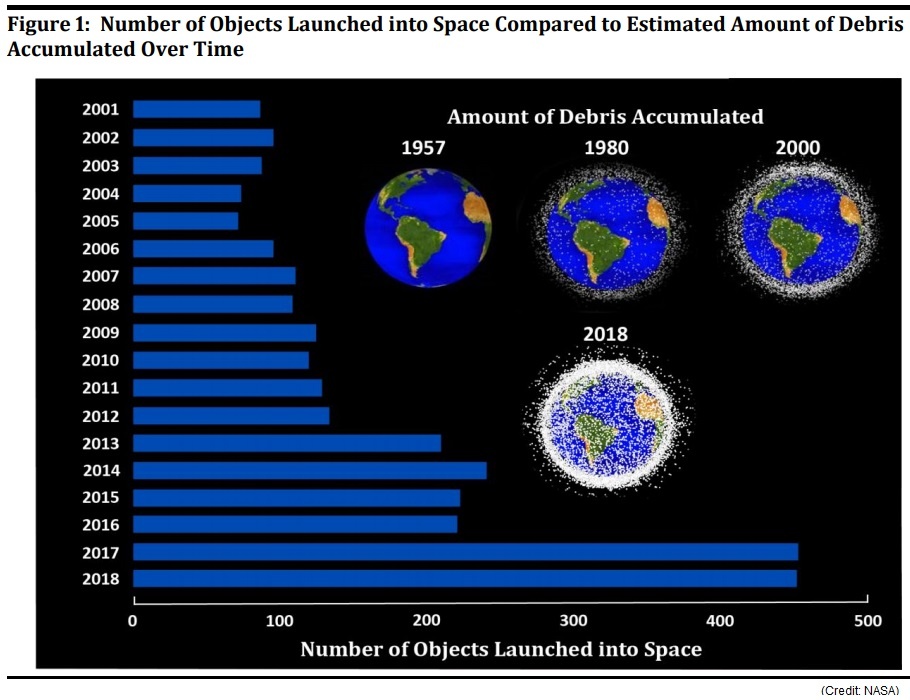
According to the CNN article Mission to clean up space junk with magnets set for launch published on March 19, 2021, “It’s invisible in the night sky, but above us there is a cloud of more than 9,000 tons of space junk — equivalent to the weight of 720 school buses. This debris is composed of parts of old satellites as well as entire defunct satellites and rocket bodies. The debris poses risks to the International Space Station and threatens things we take for granted on Earth — weather forecasting, GPS and telecommunications.”
I am assuming SpaceX will go and pick up the trash in the Rocky Mountains near the Canadian border, where its Falcon 9 stage 2 was expected to fall. The founder of SpaceX, Elon Musk, makes $432 million per day, I am sure he can afford it :-). In 2020, despite the pandemic, Elon Musk added more than $150 billion to his net worth. He is now the world’s richest man with a net worth of over $200 billion and we haven’t even reached Mars yet. I wouldn’t be surprised if his net worth is over $1 trillion by that time.
| Thanks for reading my article. If you are interested in IT consulting & training services, please reach out to me. Visit ZubairAlexander.com for information on my professional background. |
Copyright © 2021 SeattlePro Enterprises, LLC. All rights reserved.
